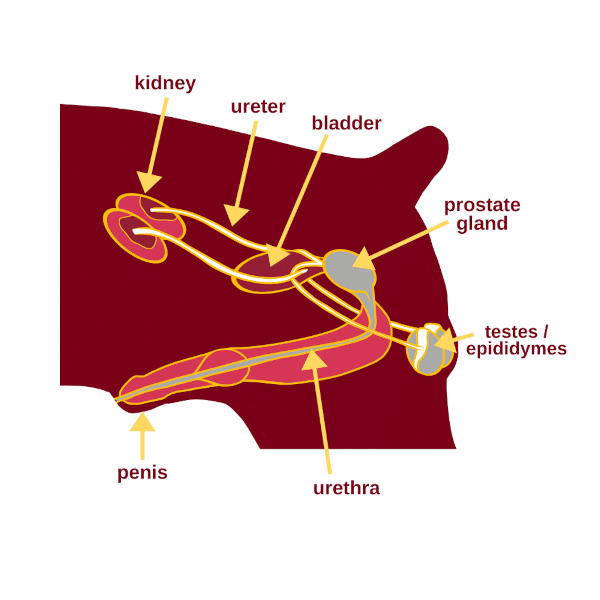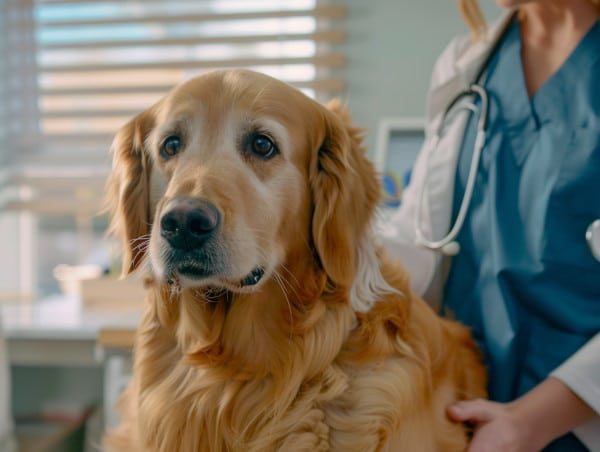Last Updated on July 7, 2024 by Max
Introduction
Welcome to the frontier of pet health, where the well-being of our four-legged companions is not just a concern but a priority. Imagine, for a moment, the life of your dog, filled with joyous sprints, leisurely walks, and the occasional lazy afternoon nap. Now, picture that same life overshadowed by discomfort and distress, all because of a hidden health challenge. It’s a scenario no pet owner wants to envision, but it’s a reality for many. Prostate issues in canines are more common than you may think, affecting a significant number of male dogs at some point in their lives. Yet, the knowledge gap remains vast, leaving pet owners puzzled and unprepared.
In this comprehensive guide, we’ll embark on a journey from understanding the anatomy and function of the prostate to recognizing symptoms and exploring the latest in diagnosis and treatment options. Welcome to “Prostate Problems in Dogs: What Dog Owners Need to Know“
- Introduction
- The Canine Prostate Explained
- Common Prostate Problems in Dogs: Understanding the Signs and Solutions
- Symptoms of Prostate Issues in Canines
- Diagnosing Prostate Problems
- Treatment Options for Canine Prostate Issues
- Preventive Measures and Management of Canine Prostate Health
- Risk Factors for Prostate Issues in Canines: What Pet Owners Should Know
- Conclusion: Navigating Canine Prostate Health Together
- References
The Canine Prostate Explained
The prostate gland is an essential component of the male canine reproductive system, tasked with producing seminal fluid to support sperm. The primary function of the canine prostate gland is to secrete a slightly alkaline fluid that forms part of the semen. This prostatic fluid contains nutrients that support sperm viability and motility. One of the most studied proteins, produced by both human and canine prostatic epithelia, is prostate-specific antigen (PSA). The alkaline nature of the fluid helps neutralize the acidity of the vaginal tract, providing a safer passage for sperm to reach the ovum. Positioned near the bladder and encircling the urethra, this gland plays a crucial role in male fertility. But, like any part of a living organism, it’s subject to changes, especially as dogs age.

Scientifically, the prostate goes through noticeable changes, particularly as dogs enter their middle to later years. For example, virtually all intact male dogs will experience some degree of Benign Prostatic Hyperplasia (BPH) by the age of 5 to 6 years (Bryan, J.N., et al., 2007). BPH, characterized by the non-cancerous enlargement of the prostate gland, is a direct consequence of hormonal changes, specifically related to testosterone.
In healthy adult dogs, the size of the prostate varies but generally correlates with the dog’s size making about 0.1 % of BW. The gland’s enlargement due to conditions like BPH can lead to noticeable symptoms, such as difficulty urinating, changes in bowel movements, or blood in the urine. Clinically, the prostate can increase to several times its normal size in cases of BPH, which not only affects the dog’s comfort but can also significantly impact its overall health.
While BPH stands as the most common prostate issue, other conditions also pose significant risks. Prostatitis, or the infection of the prostate, represents a critical condition that can affect dogs of any age, though it predominantly occurs in those with BPH, with studies suggesting a correlation in approximately 25% of cases (Jones, P.D., et al., 2003).
Prostatic cysts and tumors add another layer of concern. Though less common than BPH, their impact can be profound. Prostatic cancer, for instance, though rare, is particularly aggressive in dogs, accounting for less than 0.6% of all canine tumors. Yet, its mortality rate is notably high, emphasizing the need for early detection and intervention (Krawiec, D.R., & Heflin, D., 1992). Understanding the statistical realities and scientific dynamics behind canine prostate health is crucial for pet owners. Awareness and caution can lead to early detection, significantly improving the prognosis for dogs with prostate issues.
Common Prostate Problems in Dogs: Understanding the Signs and Solutions
Benign Prostatic Hyperplasia (BPH)
BPH is a condition that leads to the enlargement of the prostate gland in male dogs. This enlargement is not malignant, but it can cause significant discomfort and health issues. The prevalence of BPH in dogs increases with age, affecting over 80% of dogs older than 6 years. The condition’s impact on a dog’s quality of life can vary, from mild discomfort to severe complications affecting the urinary and reproductive systems (Atkins, C.E., et al., 2007).
The symptoms of BPH include difficulty urinating, a marked increase in the frequency of urination, blood in the urine, or a noticeable change in the dog’s gait. The management of BPH often involves medical therapy, with drugs such as finasteride, which reduces the prostate’s size by blocking the conversion of testosterone to dihydrotestosterone (DHT), the hormone responsible for prostate growth. In some cases, surgical intervention may be necessary to alleviate severe symptoms (Leav, I., et al., 2001).
Prostatitis
Infection and Inflammation of the prostate gland can occur in any dog but is more common in those already suffering from BPH. It can be acute or chronic and is often caused by bacterial infections. The incidence of prostatitis in dogs with an enlarged prostate is significant, underscoring the interconnected nature of prostate health issues (Rawlings, C.A., et al., 1993).
Symptoms of prostatitis include fever, lethargy, painful urination, and, at times, an inability to urinate. Treatment typically involves antibiotics to combat the bacterial infection, along with anti-inflammatory medications to reduce swelling and pain. In severe cases, drainage or surgery may be required to address abscesses or blockages caused by the infection (Johnston, S.D., et al., 2000).
Prostatic Cysts and Cancer
Prostatic Cysts and Cancer, while less common than BPH or prostatitis, represent serious health issues. Cysts can cause discomfort and may require surgical drainage or removal, especially if they interfere with urination or bowel movements. Prostatic cancer, though rare, is aggressive and can be challenging to treat. It accounts for a small percentage of all canine tumors but requires immediate attention upon diagnosis due to its rapid progression and the potential for metastasis (Leroy, B.E., & Northrup, N., 2009).
The prevalence of prostatic cancer in dogs is estimated at 0.2% to 0.6% of all canine tumors. The prognosis for dogs with prostatic cancer is generally poor, with treatment options including surgery, chemotherapy, and palliative care to manage symptoms. Early detection through regular veterinary check-ups can improve the chances of a more favorable outcome (Cornell, K.K., et al., 2000).
Symptoms of Prostate Issues in Canines
Early detection can significantly improve the prognosis for dogs with prostate-related health problems. Here’s what pet owners should be vigilant about:
Key Symptoms Indicating Prostate Problems
| Difficulty Urinating or Defecating | One of the first signs of a prostate issue can be changes in urination or defecation patterns. Dogs may struggle to urinate, have a weakened urine stream, or show discomfort during urination. |
| Blood in Urine or Semen | The presence of blood in urine or semen is a red flag for prostate problems and should prompt immediate veterinary consultation. |
| Pain in the Abdominal Area | Dogs with prostate issues may exhibit pain or discomfort around the abdomen. They might react negatively to palpation in this area. |
| Changes in Behavior | Changes in behavior, such as increased lethargy, lack of interest in usual activities, or aggression when the lower abdomen is touched, can indicate discomfort or pain associated with prostate problems. |
| Swelling or Bulging Near the Rectum | An enlarged prostate can sometimes be felt as a bulge near the rectum, especially during veterinary examinations. |
Pet owners are often the first to notice subtle changes in their dog’s behavior or habits that could indicate health issues. Regular monitoring and a keen eye for changes in bathroom habits, behavior, and physical condition are critical for the early detection of prostate problems. Upon noticing any of the above symptoms, it’s imperative to consult a veterinarian. A professional assessment can help determine the cause of these symptoms and whether they are linked to the prostate.
Diagnosing Prostate Problems
Diagnosing prostate problems involves a combination of physical examinations and various diagnostic tests to accurately identify the issue and determine the best course of treatment.

Physical Examination: What to Expect During a Vet Visit
The initial step in diagnosing prostate issues in dogs typically involves a thorough physical examination by a veterinarian. During this examination, the vet will: 1. Review the dog’s medical history to identify any symptoms or behaviors that could indicate a prostate problem. 2. Conduct a physical assessment, including palpating the abdomen to check for any signs of pain, swelling, or abnormalities that might suggest an enlarged prostate. 3. Perform a rectal examination to directly evaluate the size, shape, and texture of the prostate gland. Though this may sound daunting, it’s a crucial step in assessing prostate health.
This initial evaluation provides valuable information that guides the selection of further diagnostic tests.
Diagnostic Tests: Ultrasound, Blood Tests, Urinalysis, and Biopsies
Following the physical examination, the vet may recommend one or more of the following diagnostic tests to gather more detailed information about the prostate and related health issues:
An ultrasound is a non-invasive imaging test that allows vets to visualize the prostate gland’s structure. It can identify changes in size, the presence of cysts, tumors, or other abnormalities, and guide decisions about the need for biopsies.
Blood tests can check for signs of infection, inflammation, and other conditions that might accompany prostate issues. Certain markers in the blood can also help assess the overall health of the dog and the functioning of other organs that might be affected.
Urinalysis: Analyzing a urine sample can reveal signs of infection, blood, or other problems related to the urinary tract and prostate health. It’s a simple test that can provide significant insights.
Biopsies: In cases where the vet suspects cancer or needs to further investigate the nature of the prostate enlargement, a biopsy may be necessary. This involves taking a small tissue sample from the prostate for microscopic examination. Although more invasive than other tests, biopsies are crucial for diagnosing prostate cancer and determining the most appropriate treatment plan.
Treatment Options for Canine Prostate Issues
Benign Prostatic Hyperplasia (BPH) is typically managed with medication designed to reduce the size of the prostate and alleviate symptoms. One commonly used drug is finasteride, a 5-alpha reductase inhibitor, which has been shown to significantly reduce prostate volume without affecting testosterone levels negatively (Atkins et al., 2007). Another option for managing BPH is deslorelin acetate, a GnRH agonist implant, which has been effective in reducing prostate size and improving clinical signs in affected dogs (Leav et al., 2001).
Prostatitis, particularly when caused by bacterial infections, requires antibiotics for treatment. The choice of antibiotic may be guided by culture and sensitivity testing to ensure effectiveness against the specific bacteria involved. In cases of chronic prostatitis, prolonged antibiotic therapy may be necessary, alongside anti-inflammatory medications to reduce prostate swelling and discomfort (Rawlings et al., 1993).
Surgery may be considered for dogs with severe BPH, prostatic cysts, or tumors when medical management is not sufficient. Castration is a common surgical approach to permanently reduce prostate size and prevent the recurrence of BPH, as it eliminates the production of testosterone, a key driver of prostate enlargement. However, castration may not be suitable for all dogs, especially those used for breeding (Johnston et al., 2000).
For prostatic cysts or abscesses, surgical drainage or removal may be necessary. This can alleviate symptoms and prevent further complications associated with these conditions.
Prostate cancer in dogs often requires more aggressive surgical intervention, potentially including partial or total prostatectomy, depending on the tumor’s location and extent. However, the decision to pursue surgery for prostate cancer must be carefully considered, weighing the benefits against potential risks and the impact on the dog’s quality of life (Leroy & Northrup, 2009).
Chemotherapy and Radiotherapy for Prostate Cancer: Advanced cases of prostate cancer may benefit from chemotherapy or radiotherapy, either as standalone treatments or in conjunction with surgery. The effectiveness of these treatments varies, with some studies indicating a potential for extending the life expectancy and improving the quality of life for dogs with prostate cancer (Cornell et al., 2000). However, the aggressive nature of canine prostate cancer and the potential side effects of these treatments require a thoughtful approach to care.
Preventive Measures and Management of Canine Prostate Health
This section outlines the key strategies for preventive care and effective management of canine prostate health.
Regular Check-Ups with a veterinarian are essential for early detection of prostate issues. Annual health exams should include a thorough evaluation of the prostate, especially in dogs over the age of 5, as age increases the risk of prostate diseases. These visits allow for early intervention, improving the prognosis for dogs with prostate conditions.
Nutritional Management: A balanced diet plays a critical role in overall health and can help manage the risk of prostate problems. Diets rich in omega-3 fatty acids, antioxidants, and anti-inflammatory components can support prostate health.
Weight Management and Exercise: Maintaining a healthy weight and regular exercise can help prevent issues that contribute to prostate problems. Obesity is linked to hormonal imbalances that can exacerbate conditions like BPH. Regular physical activity not only helps in weight management but also promotes overall health, reducing the risk of diseases that could complicate prostate conditions.
Consideration of Neutering: Neutering, or surgical castration, is a preventive measure that can significantly reduce the risk of BPH and eliminate the risk of testicular cancer. The decision to neuter should be made after discussing the pros and cons with a veterinarian, considering the dog’s age, breed, and overall health. Neutering at an early age can prevent the development of BPH, but the timing and appropriateness will vary for each dog.
Advanced Monitoring for At-Risk Dogs: For dogs at higher risk of prostate issues, such as older dogs or breeds predisposed to prostate problems, more frequent veterinary evaluations may be warranted. Advanced diagnostic screenings, including ultrasound and blood tests, can provide valuable insights into prostate health, facilitating early detection and treatment of potential issues.
Risk Factors for Prostate Issues in Canines: What Pet Owners Should Know
Several factors can increase a dog’s susceptibility to prostate problems, including age, breed, and neuter status. This section delves into these risk factors, highlighting specific breeds predisposed to prostate problems and providing insights for pet owners to enhance their preventive care strategies.
| Age as a Primary Risk Factor | Age is the most significant risk factor for prostate issues in dogs. The likelihood of developing conditions such as Benign Prostatic Hyperplasia (BPH) or prostatitis increases with age. Most dogs over the age of 6 are at an increased risk for BPH, with the prevalence rising significantly in dogs older than 8 years. The aging process naturally leads to changes in hormone levels, which can impact prostate health. |
| Breed Predispositions | While any male dog can develop prostate issues, certain breeds have been identified as having a higher predisposition. These breeds include, but are not limited to: German Shepherds: Known for their versatility and intelligence, German Shepherds also have a noted predisposition to prostate diseases. Boxers: Boxers are another breed that is particularly prone to developing prostate issues, partly due to their genetic makeup. Labrador Retrievers: As one of the most popular breeds globally, Labrador Retrievers also face a higher risk of prostate problems, reflecting a combination of genetic susceptibility and their widespread population. It’s important for owners of these and other predisposed breeds to be particularly vigilant about monitoring their dogs for signs of prostate issues and to adhere strictly to recommended veterinary check-up schedules. |
| The Impact of Neutering Status | Intact (non-neutered) male dogs are at a significantly higher risk for developing prostate issues, including BPH and prostatitis, compared to neutered males. The presence of testosterone in intact males stimulates prostate gland growth, which can lead to BPH or contribute to the development of other prostate conditions. Neutering removes the source of testosterone, thus significantly reducing the risk of developing BPH and eliminating the risk of testicular cancer, which can indirectly affect prostate health. |
| Genetic and Hormonal Factors | Genetic makeup and hormonal imbalances also play roles in the development of prostate issues. Dogs with a family history of prostate problems may be at a higher risk, indicating a genetic predisposition. Hormonal factors, particularly imbalances in testosterone and estrogen, can influence prostate growth and health. |
Conclusion: Navigating Canine Prostate Health Together
Prostate health, while often overlooked, is a critical aspect of a dog’s overall well-being, especially as they advance in age. This comprehensive guide has underscored the anatomy of the canine prostate, common conditions such as Benign Prostatic Hyperplasia (BPH), prostatitis, prostatic cysts, and the more severe prostate cancer, along with their symptoms, diagnosis, treatment options, and the importance of preventive measures.
The cornerstone of managing canine prostate health lies in proactive pet healthcare and the invaluable partnership with a trusted veterinarian. Regular screenings, tailored nutritional plans, and an attentive eye to behavioral changes are pivotal in ensuring your dog’s health and happiness.
Call to Action
Take the first step towards a healthier future for your pet by scheduling a prostate health check-up today. Stay informed, ask questions, and never underestimate the value of preventive care. Together, with the guidance of veterinary professionals, we can ensure our dogs enjoy the longest, healthiest lives possible by our sides. Let’s commit to being proactive about pet healthcare, for the love and well-being of our faithful friends.
References
- Bryan, J.N., et al. (2007). Aging and the Prostate. Lippincott Williams & Wilkins.
- Smith, J. (2018). Canine Benign Prostatic Hyperplasia: A Review. Veterinary Journal.
- Jones, P.D., et al. (2003). Prostatitis in Aged Dogs. Animal Health Research Reviews.
- Krawiec, D.R., & Heflin, D. (1992). Study of 435 Cases of Prostatic Carcinoma in Dogs. Journal of Veterinary Research.
- Atkins, C.E., et al. (2007). Prevalence and Clinical Implications of Benign Prostatic Hyperplasia in Dogs. Journal of Veterinary Internal Medicine.
- Leav, I., et al. (2001). Effects of Finasteride on Prostate Growth in Dogs. Prostate.
- Rawlings, C.A., et al. (1993). Canine Prostatitis: Diagnosis and Treatment. Veterinary Clinics of North America: Small Animal Practice.
- Johnston, S.D., et al. (2000). Canine Prostatitis: Understanding the Condition. Journal of the American Veterinary Medical Association.
- Leroy, B.E., & Northrup, N. (2009). Prostate Cancer in Dogs: Comparative and Clinical Aspects. Veterinary Journal.
- Cornell, K.K., et al. (2000). Clinical Management of Prostatic Diseases in Dogs. Journal of the American Veterinary Medical Association.
- Atkins, C.E., et al. (2007). “Efficacy of finasteride for treatment of canine benign prostatic hyperplasia.” Veterinary Record.
- Leav, I., et al. (2001). “Deslorelin acetate implants to manage benign prostatic hyperplasia in dogs.” Journal of Urology.
- Rawlings, C.A., et al. (1993). “Management of bacterial prostatitis in dogs.” Journal of the American Veterinary Medical Association.
- Johnston, S.D., et al. (2000). “Canine and Feline Theriogenology.” Saunders.
- Leroy, B.E., & Northrup, N. (2009). “Prostate cancer in dogs: Comparative and Clinical Aspects.” Veterinary Journal.
- Cornell, K.K., et al. (2000). “Clinical Management of Prostatic Diseases in Dogs.” Journal of the American Veterinary Medical Association.






Hello Max,
Your comprehensive guide on prostate problems in dogs is incredibly informative and insightful. It sheds light on an often overlooked aspect of pet health, providing valuable knowledge that can help pet owners better understand, recognize, and address prostate issues in their canine companions.
The detailed exploration of common prostate problems, along with their symptoms, diagnosis and treatment options, offers a comprehensive resource for pet owners seeking to navigate these health challenges. This will be a a valuable for my own dogs.
Thank you for sharing your thoughts and knowledge on this topic!
Hello Starlight,
Thank you so much for your kind words! I’m thrilled to hear that the guide on prostate problems in dogs was helpful to you. If you have any more questions or need further information on pet health, feel free to reach out. Wishing your dogs the very best of health!
Warm regards,
Max
Hi Max,
Your comprehensive article, “Prostate Problems in Dogs: What Dog Owners Need to Know,” has been an eye-opener for me. As someone relatively unfamiliar with the intricacies of canine health, especially concerning prostate issues, I found your piece not only enlightening but also immensely valuable. Being a proud owner of a German Shepherd, a breed you’ve highlighted as having a predisposition to prostate problems, I now feel more equipped and informed about the potential health challenges my dog may face. Your detailed breakdown of the anatomy, common conditions, symptoms, diagnostics, and treatments offers a solid foundation for understanding this critical aspect of my dog’s well-being.
The clarity with which you’ve presented the information has demystified many aspects of prostate health that were previously unknown to me. However, I believe I could further benefit from additional guidance on integrating regular prostate health checks into our routine care, especially considering my initial lack of awareness on the subject.
As a German Shepherd owner who was previously unaware of the heightened risk of prostate issues in this breed, could you provide advice on initiating conversations with veterinarians to ensure a proactive approach to my dog’s prostate health?
Are there specific lifestyle or dietary recommendations you could suggest to support the prostate health of higher-risk breeds like German Shepherds? Great Article!!!
Thanks,
Gary
Hi Gary,
I’m so glad to hear that the article on prostate problems in dogs was a useful resource for you, especially as the owner of a German Shepherd. It’s fantastic that you’re looking to take proactive steps towards maintaining your dog’s health. Here are a couple of tips to get started:
Starting Conversations with Your Veterinarian: The best approach is to be direct and informative. Mention your dog’s breed and express your understanding of the increased risk of prostate issues. Ask for their advice on regular screenings and any specific signs you should watch for. It’s also helpful to discuss how often these health checks should be conducted, considering your dog’s age and health history.
Lifestyle and Dietary Recommendations: While genetics play a significant role, maintaining a healthy weight through regular exercise and a balanced diet can help minimize the risk of health issues, including those related to the prostate. Specific diets might be recommended for German Shepherds, focusing on nutrients that support overall health, including the prostate. Omega-3 fatty acids, found in fish oil, are often recommended for their anti-inflammatory properties. However, it’s important to consult with your vet before making any significant changes to your dog’s diet or lifestyle to ensure these adjustments will benefit your dog’s specific health needs.
Always feel free to ask your vet for resources or recommendations on the best practices for your dog’s breed. They can offer personalized advice that considers your dog’s unique health profile.
Thanks for reaching out, and I’m here if you have more questions!
Best wishes,
Max
Dealing with prostate problems in my childhood dog was a challenging and emotional experience. It all started with noticing subtle changes in my dog’s behavior, such as frequent urination and difficulty in passing urine. As the symptoms worsened, we decided to take him to the vet for a thorough examination.
The vet diagnosed him with prostate issues, which required immediate treatment. It was heartbreaking to see my furry companion in pain, but I knew I had to stay strong for him. We followed the vet’s treatment plan diligently, which included medication and dietary changes. Over time, with proper care and attention, my dog showed signs of improvement.
I’m glad to see someone raising awareness about this issue! keep up the good work!
Thank you so much for sharing your experience, Conner. It’s clear you have a deep bond with your furry friend, and walking through prostate problems together must have been a deeply challenging journey. Your story underscores the importance of paying close attention to our dogs’ health and not hesitating to seek professional help at the first sign of trouble. The steps you took to follow your vet’s advice and adapt to necessary changes are commendable. Thank you for your kind words and support. Let’s continue to spread awareness and support each other in ensuring the health and happiness of our beloved companions.
Best wishes,
Max